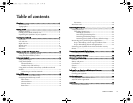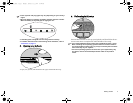
Touring your Joybook 7
Left side view
Accepts an analog telephone line for use with the internal modem.
• To reduce the risk of fire, ensure that your phone cable is of adequate
capacity and approved for use with your local telecommunications
supplier.
• This is the only telecommunications modem port on the Joybook.
Please be careful to avoid plugging a narrow RJ-11 phone cable into the
similar looking but wider RJ-45 LAN port adjacent.
Allows Joybook to connect to a 10/100Mbps fast Ethernet 100BASE-T
network.
Please be careful to avoid plugging a RJ-11 phone cable connector in the
RJ-45 port. This will damage the LAN port. They look similar, but the RJ-
45 connector is wider than the RJ-11 connector, and has more
conductors.
(3) Ventilation holes
For dissipating heat and keeping the computer at an optimal
temperature.
(4) USB port
For connecting peripherals such as mice, digital cameras and MP3 players
that use the USB 2.0 interface.
(5) PCMCIA Card expansion slot
This slot accepts one Type-II PCMCIA Card. You can use it and various
PCMCIA Cards on the market to further expand the capabilities of your
Joybook.
Insert the PCMCIA Card into the slot following the direction indicated
on the card. Then, complete related driver settings according to the
documentation that came with the card.
(6) PCMCIA Card ejection button
Before ejecting a PCMCIA Card:
1. Quit all PCMCIA Card applications and shut down all PCMCIA Card
functions.
2. Push in, and then release the PCMCIA Card eject button, causing it to
pop out.
3. When the button has popped out, push it in again to eject the
PCMCIA Card.
(1)
Modem port (RJ-11 connector)
(2)
LAN (Local Area Network) port (RJ-45 connector)
JB_A52.book Page 7 Monday, February 12, 2007 10:44 AM


















